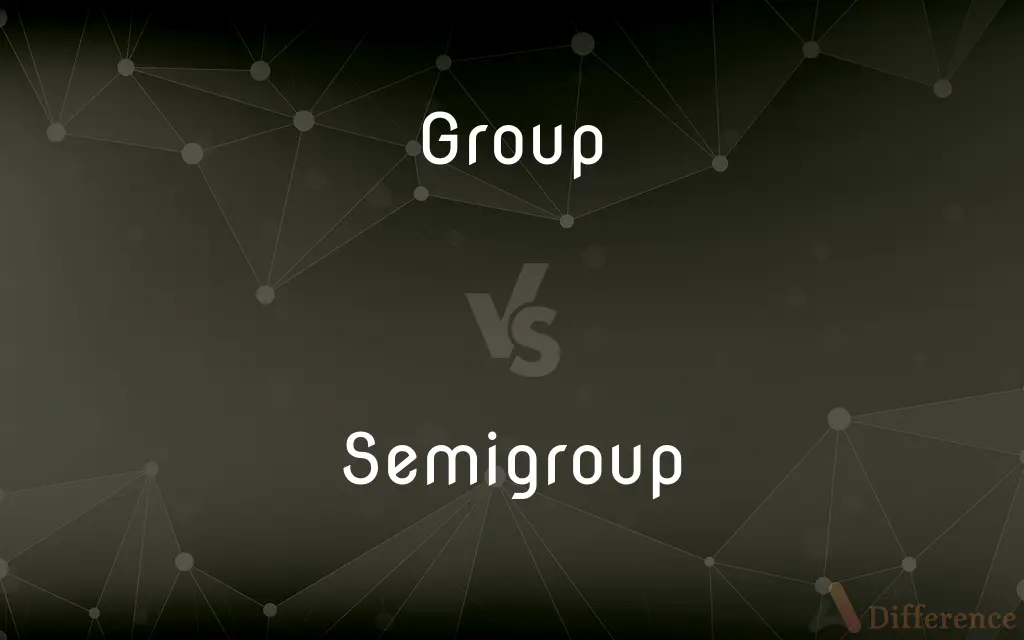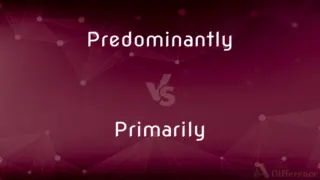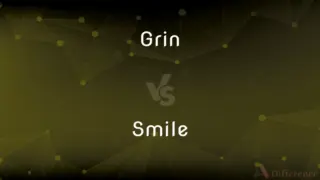Group vs. Semigroup — What's the Difference?
By Maham Liaqat & Fiza Rafique — Updated on March 27, 2024
A group combines elements with a binary operation adhering to closure, associativity, identity, and inverse properties. A semigroup, lacking identity and inverse, requires only closure and associativity.

Difference Between Group and Semigroup
Table of Contents
ADVERTISEMENT
Key Differences
A group and a semigroup are both algebraic structures defined on sets with a binary operation, but they differ significantly in terms of the properties that their operations must satisfy. The concept of a group is foundational in abstract algebra and has applications in various areas of mathematics and science due to its comprehensive structure that includes operations mimicking addition and multiplication in a way that allows for both composition and reversal of actions.
A group requires four main properties to be satisfied: closure, meaning the operation on any two elements of the set results in another element of the set; associativity, indicating that the operation's result does not depend on the grouping of elements; the existence of an identity element, which, when combined with any element of the set, results in that element itself; and the existence of inverse elements, ensuring that for every element in the set, there is another element that combines with it to produce the identity element. On the other hand, a semigroup is defined by just two of these properties: closure and associativity. It does not require an identity element or inverse elements, making it a simpler structure. This makes semigroups applicable in situations where operations are combinatory and associative but not necessarily reversible, such as string concatenation or matrix multiplication under certain conditions.
While a group's structure allows for a wide range of mathematical manipulations and theorems, including solving equations and understanding symmetries, a semigroup's simpler structure is useful in the study of processes and systems where only combination operations are considered, without the need for identity or inversion.
An extension of a semigroup is a monoid, which adds the requirement of an identity element but still does not require inverse elements. This positions monoids between groups and semigroups in terms of structural complexity, highlighting the nuanced differences among these algebraic structures based on the properties of their binary operations.
The choice between using a group or a semigroup depends on the specific mathematical or practical problem being addressed. Groups are suited to scenarios where every action (operation) can be undone, while semigroups are sufficient for analyzing sequences of actions where only the cumulative effect is of interest.
ADVERTISEMENT
Comparison Chart
Closure
Required
Required
Associativity
Required
Required
Identity Element
Required
Not required
Inverse Elements
Required
Not required
Structure Complexity
More complex
Simpler
Application Examples
Symmetry operations, solving equations
String concatenation, certain types of matrix multiplication
Compare with Definitions
Group
Allows for the reversal of operations.
In a group, adding an element and its inverse results in the identity element.
Semigroup
Applicable where operations combine elements in a non-reversible manner.
The concatenation of strings forms a semigroup.
Group
A set with a binary operation satisfying closure, associativity, identity, and inverse properties.
The set of integers under addition forms a group.
Semigroup
Useful in the analysis of sequential processes.
Transition systems in computer science can be modeled as semigroups.
Group
Fundamental in abstract algebra and many areas of mathematics.
Group theory is crucial in understanding the structure of equations.
Semigroup
A set with a binary operation that is closed and associative.
The set of positive integers under multiplication forms a semigroup.
Group
Encompasses a wide range of mathematical phenomena.
The permutation group captures the concept of rearranging objects.
Semigroup
Provides a foundational structure for more complex algebraic studies.
Semigroup theory is a stepping stone to understanding monoids and groups.
Group
Used to model symmetries and mathematical structures.
The rotational symmetry of a square forms a group.
Semigroup
Simpler than groups, lacking identity and inverse elements.
Matrix multiplication can form a semigroup when not all matrices are invertible.
Group
An assemblage of persons or objects gathered or located together; an aggregation
A group of dinner guests.
A group of buildings near the road.
Semigroup
In mathematics, a semigroup is an algebraic structure consisting of a set together with an associative binary operation. The binary operation of a semigroup is most often denoted multiplicatively: x·y, or simply xy, denotes the result of applying the semigroup operation to the ordered pair (x, y).
Group
A set of two or more figures that make up a unit or design, as in sculpture.
Semigroup
A set for which there is a binary operation that is closed and associative.
Group
A number of individuals or things considered or classed together because of similarities
A small group of supporters across the country.
Semigroup
(mathematics) Any set for which there is a binary operation that is closed and associative.
Group
(Linguistics) A category of related languages that is less inclusive than a family.
Group
A military unit consisting of two or more battalions and a headquarters.
Group
A unit of two or more squadrons in the US Air Force, smaller than a wing.
Group
Two or more atoms behaving or regarded as behaving as a single chemical unit.
Group
A column in the periodic table of the elements.
Group
(Geology) A stratigraphic unit, especially a unit consisting of two or more formations deposited during a single geologic era.
Group
(Mathematics) A set, together with a binary associative operation, such that the set is closed under the operation, the set contains an identity element for the operation, and each element of the set has an inverse element with respect to the operation. The integers form a group under the operation of ordinary addition.
Group
Of, relating to, constituting, or being a member of a group
A group discussion.
A group effort.
Group
To place or arrange in a group
Grouped the children according to height.
Group
To belong to or form a group
The soldiers began to group on the hillside.
Group
A number of things or persons being in some relation to one another.
There is a group of houses behind the hill;
He left town to join a Communist group
A group of people gathered in front of the Parliament to demonstrate against the Prime Minister's proposals.
Group
(group theory) A set with an associative binary operation, under which there exists an identity element, and such that each element has an inverse.
Group
An effective divisor on a curve.
Group
A (usually small) group of people who perform music together.
Did you see the new jazz group?
Group
(astronomy) A small number (up to about fifty) of galaxies that are near each other.
Group
(chemistry) A column in the periodic table of chemical elements.
Group
(chemistry) A functional group.
Nitro is an electron-withdrawing group.
Group
(sociology) A subset of a culture or of a society.
Group
(military) An air force formation.
Group
(geology) A collection of formations or rock strata.
Group
(computing) A number of users with the same rights with respect to accession, modification, and execution of files, computers and peripherals.
Group
An element of an espresso machine from which hot water pours into the portafilter.
Group
(music) A number of eighth, sixteenth, etc., notes joined at the stems; sometimes rather indefinitely applied to any ornament made up of a few short notes.
Group
(sports) A set of teams playing each other in the same division, while not during the same period playing any teams that belong to other sets in the division.
Group
(business) A commercial organization.
Group
(transitive) To put together to form a group.
Group the dogs by hair colour
Group
(intransitive) To come together to form a group.
Group
A cluster, crowd, or throng; an assemblage, either of persons or things, collected without any regular form or arrangement; as, a group of men or of trees; a group of isles.
Group
An assemblage of objects in a certain order or relation, or having some resemblance or common characteristic; as, groups of strata.
Group
A variously limited assemblage of animals or plants, having some resemblance, or common characteristics in form or structure. The term has different uses, and may be made to include certain species of a genus, or a whole genus, or certain genera, or even several orders.
Group
A number of eighth, sixteenth, etc., notes joined at the stems; - sometimes rather indefinitely applied to any ornament made up of a few short notes.
Group
To form a group of; to arrange or combine in a group or in groups, often with reference to mutual relation and the best effect; to form an assemblage of.
The difficulty lies in drawing and disposing, or, as the painters term it, in grouping such a multitude of different objects.
Group
Any number of entities (members) considered as a unit
Group
(chemistry) two or more atoms bound together as a single unit and forming part of a molecule
Group
A set that is closed, associative, has an identity element and every element has an inverse
Group
Arrange into a group or groups;
Can you group these shapes together?
Group
Form a group or group together
Common Curiosities
How does associativity affect the structure of groups and semigroups?
Associativity ensures that the order in which operations are performed does not affect the outcome, making the algebraic structure predictable and stable. This property is crucial for both groups and semigroups, allowing for the composition of multiple operations without ambiguity.
Can a semigroup become a group?
A semigroup cannot become a group unless it satisfies the additional requirements of having an identity element and inverse elements for all its members.
Are all groups also semigroups?
Yes, since groups satisfy all the properties of semigroups (closure and associativity) and more, all groups can be considered semigroups, but not all semigroups are groups.
Can examples of semigroups be found in everyday life?
Yes, semigroups can model many processes where combining actions is possible, but reversing them is not straightforward, such as combining ingredients in cooking or concatenating text in writing.
What makes a monoid different from a semigroup and a group?
A monoid is like a semigroup with the addition of an identity element, making it more complex than a semigroup but still lacking the inverse element requirement that defines a group.
Why is the identity element important in a group?
The identity element is crucial in a group because it allows for the definition of inverse elements, enabling the reversal of operations and the construction of more complex mathematical structures.
How does the concept of a group apply to symmetry?
In symmetry, groups model the set of all possible transformations that maintain an object's structure, such as rotations and reflections, allowing for a comprehensive understanding of the object’s symmetrical properties.
What is an example of a mathematical problem that can be solved using group theory?
Group theory can solve problems related to the symmetries of geometric objects. For instance, determining the possible ways to rotate a cube such that it looks the same after the rotation involves group theory, specifically the study of the cube’s rotational symmetry group.
What role do inverse elements play in the functionality of a group?
Inverse elements allow for the "undoing" of operations within a group, ensuring that for every action, there is a corresponding action that returns the system to its initial state. This property is essential for many mathematical and physical systems, providing a mechanism for reversibility and balance.
Why might someone choose to study semigroups instead of groups?
Researchers might focus on semigroups when interested in processes where combining actions is significant, but the ability to reverse those actions is not necessary or relevant. Semigroups offer a simpler framework that is sufficient for analyzing such processes, particularly in computer science and information theory.
Can the concept of groups be applied to fields outside of mathematics?
Yes, group theory finds applications in various fields outside of mathematics, including physics, chemistry, and computer science. In physics, for example, group theory helps understand the symmetries underlying fundamental forces and particles. In chemistry, it aids in studying the molecular symmetries and their implications for chemical reactions.
Share Your Discovery

Previous Comparison
Predominantly vs. Primarily
Next Comparison
Grin vs. SmileAuthor Spotlight
Written by
Maham LiaqatCo-written by
Fiza RafiqueFiza Rafique is a skilled content writer at AskDifference.com, where she meticulously refines and enhances written pieces. Drawing from her vast editorial expertise, Fiza ensures clarity, accuracy, and precision in every article. Passionate about language, she continually seeks to elevate the quality of content for readers worldwide.















































